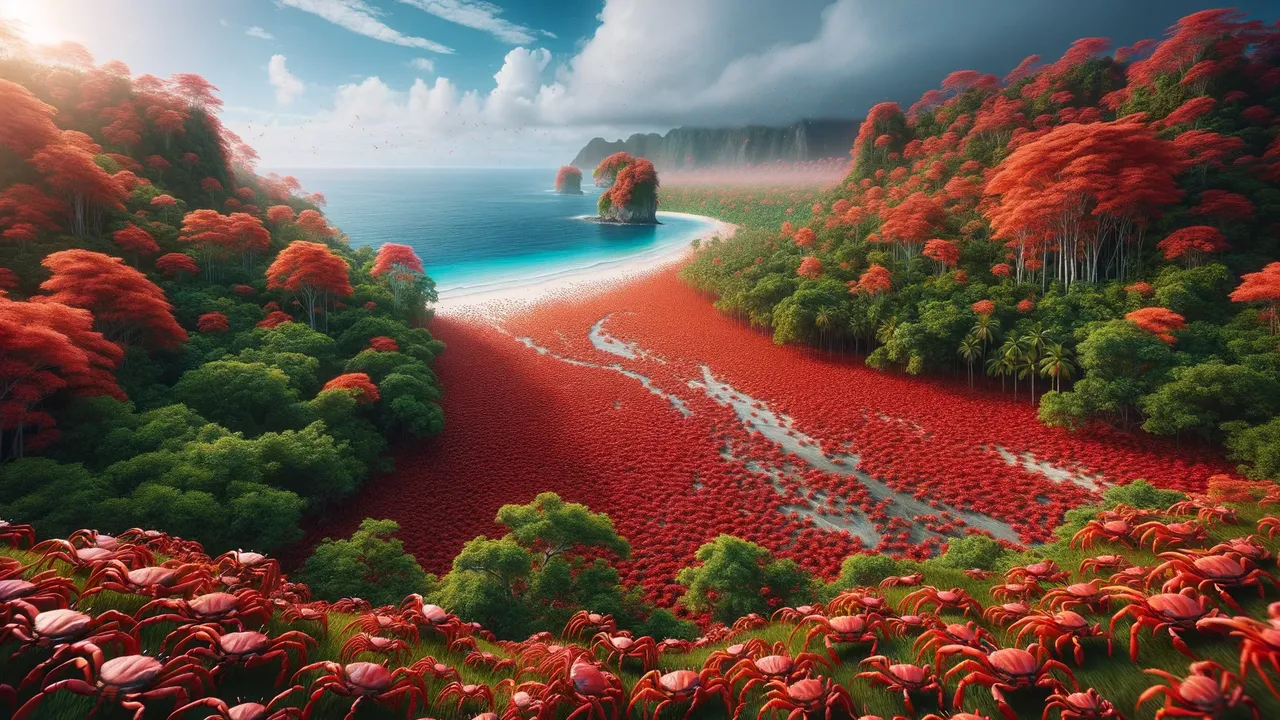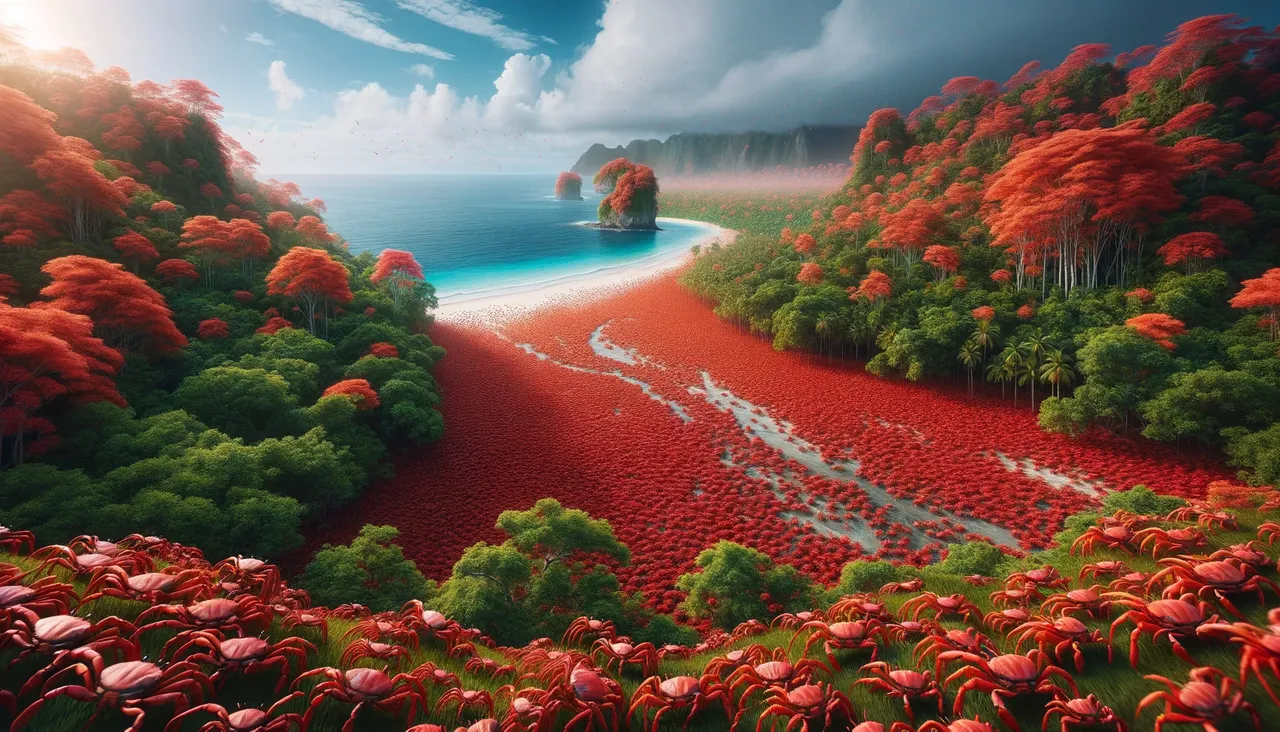
Red Crabs Spectacle on Christmas Island
Every year, Christmas Island transforms into a mesmerizing stage for the natural spectacle of the red crabs’ migration. These vibrant creatures embark on an epic journey from the island’s lush forests to its coastal shores, painting the landscape in brilliant shades of red. This unique event not only captivates wildlife enthusiasts but also highlights the ecological significance of the red crabs to the island’s biodiversity. Witnessing this phenomenon offers a rare glimpse into the intricate balance of nature’s wonders on Christmas Island.
The Great Migration Unveiled
On Christmas Island, the red crab migration is a stunning natural event, where millions of red crabs emerge from the forest to spawn at the sea. This mass exodus starts with the onset of the wet season, usually around October or November, when the island receives its first significant rainfall. The crabs’ journey is timed with the lunar cycle, ensuring their eggs are released into the ocean during the high tide.
“Christmas Island’s red crabs, in their journey, weave nature’s intricate tapestry.”
As the crabs travel, they create a spectacular red carpet across the island, covering roads, beaches, and trails. The local community and authorities work together to facilitate this migration, setting up barriers and closing roads to protect the crabs from vehicular threats. This concerted effort underscores the island’s commitment to preserving its unique wildlife.
The destination of this arduous journey is the coastline, where female crabs release their eggs into the ocean. This synchrony with the tides maximizes the survival chances of the larvae, which will spend the initial phase of their life in the sea before returning to land.
Christmas Island’s Red Delight
Christmas Island is home to a unique natural phenomenon that captivates visitors from around the world: the annual migration of red crabs. These vibrant creatures are a source of wonder and intrigue, painting the island in a vivid shade of red each year. Their presence is not only a delight for the eyes but also an essential part of the island’s ecosystem, contributing to the nutrient cycle of the tropical forest.
Observing the red crabs in their natural habitat offers an unparalleled wildlife experience. The sight of millions of crabs moving in unison is both awe-inspiring and humbling, reminding us of the wonders of the natural world. For nature lovers and photographers, this event provides a rare opportunity to capture the beauty of these creatures in their element.
“In the dance of nature, Christmas Island’s red crabs lead a vivid ballet.”
The red crabs’ migration also plays a crucial role in the local culture and economy, attracting tourists and nature enthusiasts to the island. This influx of visitors supports local businesses and promotes conservation efforts, highlighting the importance of sustainable tourism in preserving natural wonders.
Read Also: Journey from Kuta to Nusa Dua: Distance Guide
Crabs on the Move
When the migration season arrives, the red crabs of Christmas Island begin their remarkable journey. Triggered by the onset of the rainy season, these crustaceans leave their forest homes en masse, heading towards the ocean to breed. Their movement is an annual ritual, deeply ingrained in the island’s natural cycle, and a spectacle that draws attention worldwide.
“Amidst the verdant isle, a crimson wave of crabs heralds nature’s march.”
Navigating through the island’s terrain, the crabs face numerous challenges, from natural predators to human-made obstacles. Conservation efforts have led to the creation of special crab crossings and bridges to ensure their safe passage. These initiatives reflect the community’s respect and admiration for these creatures and their vital role in the ecosystem.
As the crabs march towards the coast, their path becomes a living tapestry of red, creating a stunning visual feast. This event not only showcases the crabs’ instinctual determination but also the island’s rich biodiversity and the interconnectedness of its inhabitants.
A Unique Island Phenomenon
Christmas Island offers a rare natural event that stands out on the global stage. Its red crab migration is not just a local curiosity but a world-renowned ecological marvel. This phenomenon is unique due to the sheer number of crabs involved and their synchronized movement across the island’s terrain, a sight few places on Earth can boast.
The lifecycle and behavior of these crabs have adapted perfectly to the island’s environment, illustrating a fascinating example of nature’s adaptability. The crabs’ journey is a critical part of the ecosystem, helping to shape the landscape and maintain the health of the forest floor. This intricate ecological process underscores the island’s importance as a natural habitat.
“Christmas Island’s crabs, in rhythmic march, unveil the pulse of nature’s realm.”
Furthermore, the event encapsulates the delicate balance between land and sea, showcasing the interdependence of terrestrial and marine ecosystems. The successful completion of the crabs’ migration cycle is crucial for the regeneration of their population, ensuring the continuity of this extraordinary natural event.
Red Crabs’ Life Cycle
The life cycle of Christmas Island’s red crabs is a captivating natural process, beginning with their birth in the ocean. After hatching, the larvae spend their initial weeks in the sea, undergoing several developmental stages before returning to land. This early part of their life is fraught with challenges, as they are vulnerable to aquatic predators and the currents of the ocean.
“In the dance of life and tide, red crabs of Christmas Island thrive.”
Once on land, the young crabs make their way to the forest, where they will spend most of their lives. The forest offers shelter and food, allowing them to grow and mature away from the harsher coastal environment. This period of growth is slow but essential, with crabs taking several years to reach adulthood.
Adult red crabs then participate in the annual migration to the coast to breed, continuing the life cycle. The females lay their eggs in the ocean, where they hatch and start the cycle anew. This cyclical journey is not only a remarkable natural event but also critical for the survival of the species.
Tourism and Conservation Efforts
Christmas Island’s natural beauty and unique wildlife have made it a popular destination for eco-tourists and nature enthusiasts. The island’s authorities and local community have recognized the importance of balancing tourism with environmental conservation. They have implemented measures to protect the natural habitat, particularly during the red crab migration, which is a major tourist attraction.
Educational programs and guided tours are offered to visitors to raise awareness about the ecological significance of the red crabs and other native species. These initiatives aim to foster a sustainable relationship between tourists and the island’s environment, ensuring that visitors leave with a greater appreciation and understanding of the need for conservation.
“Safeguarding nature’s marvels, Christmas Island balances tourism with conservation.”
Efforts to conserve the island’s natural heritage include habitat restoration, research on wildlife, and the regulation of tourist activities to minimize environmental impact. These conservation strategies help to ensure that the island remains a vibrant ecosystem and continues to be a haven for its unique wildlife and a destination for responsible tourism.
Read Also: Embracing Family Tourism Through Outdoor Fun
Experiencing the Red Crab Season
Visiting Christmas Island during the red crab migration offers a unique and unforgettable experience. The island buzzes with activity as the crabs begin their journey, creating a natural spectacle that attracts visitors from all corners of the globe. The sight of the landscape transforming with the moving sea of red crabs is both mesmerizing and awe-inspiring.
“Witnessing the red crab migration on Christmas Island is a journey into nature’s heart.”
To fully appreciate this natural event, visitors are encouraged to explore the island’s viewing platforms and follow the guided trails that allow for close observation without disturbing the crabs. Local guides provide insights into the crabs’ behavior and the ecological importance of the migration, enhancing the visitor experience. The best times to witness this phenomenon are at the beginning and end of the migration period, when the crabs are most active.
For those planning to experience the red crab season, it is important to book accommodations and tours well in advance, as this is a popular time to visit the island. Being part of this natural event is not just a journey to a remote destination but a journey into the heart of nature’s most fascinating rituals.

Christmas Island, with its unique red crab migration, offers a remarkable spectacle that captivates the imagination and draws nature enthusiasts from around the world. This extraordinary event not only highlights the island’s rich biodiversity but also emphasizes the importance of conservation efforts to protect these unique natural phenomena. As the crabs traverse the island, creating a sea of red, they symbolize the delicate balance of nature and the need for sustainable coexistence with wildlife. The experience of witnessing this event on Christmas Island is a poignant reminder of nature’s wonders, offering both a visual feast and a deeper appreciation for the world’s ecological treasures.

